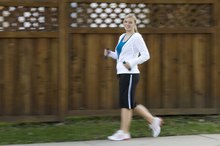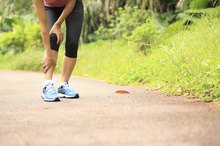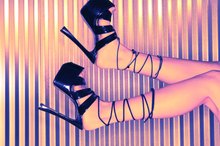Calf & Heel Pain
The calves are the fleshy part of the legs below the knees and have two key muscles.
The gastrocnemius is larger muscle and functions to move the foot downward and to bend the knee. It is posterior to, or behind, the soleus, which also moves the foot downward.
Both of these muscles taper down to the Achilles tendon, which attaches at the heel. Calf and heel pain may occur separately or in both locations at the same time.
Significance
The downward movement of the foot that the gastroc and soleus are responsible for is called plantar flexion.
When pain appears in the calves and heels, it is difficult to walk. Not only do you constantly plantar flex your foot when you walk, but your heel needs to contact the ground.
Calf and heel pain also has an effect on your daily chores. For example, every time you lift up on your tip toes to reach into a cupboard, calf pain can make this difficult.
- The downward movement of the foot that the gastroc and soleus are responsible for is called plantar flexion.
- When pain appears in the calves and heels, it is difficult to walk.
Causes
Running and Pain in the Tibialis Anterior Muscle
Learn More
Tight calf muscles are one of the main reasons all calf and heel pain develops.
When the calves contract forcefully and form a knot, it is called a cramp. These may take place during a race, sporting event or in the middle of the night.
The muscles of the calf also may take place during a sporting activity. When you strain these muscles, fibers get torn.
Plantar fasciitis is a condition that causes heel pain.
With this condition, a strong cord of tissue under the foot called the plantar fascia gets irritated. This runs from the heel toward the toes. Achilles tendonitis is an inflammation of that tendon.
- Tight calf muscles are one of the main reasons all calf and heel pain develops.
- Plantar fasciitis is a condition that causes heel pain.
Treatments
Pain relieving over-the-counter drugs like ibuprofen and acetaminophen may be used to treat heel and calf pain.
Elevating the injured heel, applying ice and wearing night splints all treat plantar fasciitis and Achilles tendonitis as well. In the worst cases of plantar fasciitis, the plantar fascia is partially released in a surgical procedure.
Massaging is another treatment used to treat calf cramps.
When a calf injury first takes place, the RICE treatment is used. This stands for rest, ice, compression and elevation. Heel pads are another treatment. They get placed in the shoes to cushion and elevate the heels. When the heels are elevated, there is less stress on the calf muscles.
- Pain relieving over-the-counter drugs like ibuprofen and acetaminophen may be used to treat heel and calf pain.
- In the worst cases of plantar fasciitis, the plantar fascia is partially released in a surgical procedure.
Prevention/Solution
Recovery Time for a Torn Plantar Fascia
Learn More
To prevent all the conditions that cause calf and heel pain, stretch well before and after exercise. Also make adjustments with your activities and lifestyle. According to MayoClinic.com, long-distance running, standing on hard surfaces for long hours and wearing shoes that are thin-soled, loose, or lack arch support or the ability to absorb shock all lead to plantar fasciitis. If you have a job that causes you to stand for long periods of time, take rest breaks.
If you are an athlete, do not overtrain, and always wear shoes that are well padded. Staying well hydrated and getting a good supply of potassium, sodium and carbohydrates in the diet is a preventive measure for calf cramps.
Stretches for the calf muscles keep them elongated and flexible. In doing so, this takes more pressure off the heels and reduces the chances of pain. Wall stretches, step stretches and towel stretches are all effective for the calves.
A downward facing dog is a yoga pose that stretches the calves and muscles in the bottom of the feet to keep the muscles limber. To do this exercise, kneel on all fours, place your hands shoulder-width apart on the floor and place your feet together. Lift your hips in the air, shift your weight back into your legs and press through the heels. Keep your arms, back and legs straight. When doing this pose, pay attention to the stretch on your calves and the bottom of your feet.
- To prevent all the conditions that cause calf and heel pain, stretch well before and after exercise.
- Lift your hips in the air, shift your weight back into your legs and press through the heels.
Warning
If you have pain in your calf or heel and restructure the way you walk, this can have an impact on your knees, hips, back, shoulders and neck. All of these joints are part of what's called the kinetic chain--a continual link of joints and muscles that run from your feet up to your head. When you favor one side of your body, you create excess stress, pain or muscle imbalances somewhere along the kinetic chain.
Related Articles
References
Resources
Writer Bio
I am very genuine and magnetic on camera, and have made numerous videos on my own for clients and other organizations that I'm affiliated with. I also have a degree in Sport Management, and multiple certifications to back up my validity. I've also been featured in three different exercise infomercials and had a speaking role in a National Lampoons movie.









